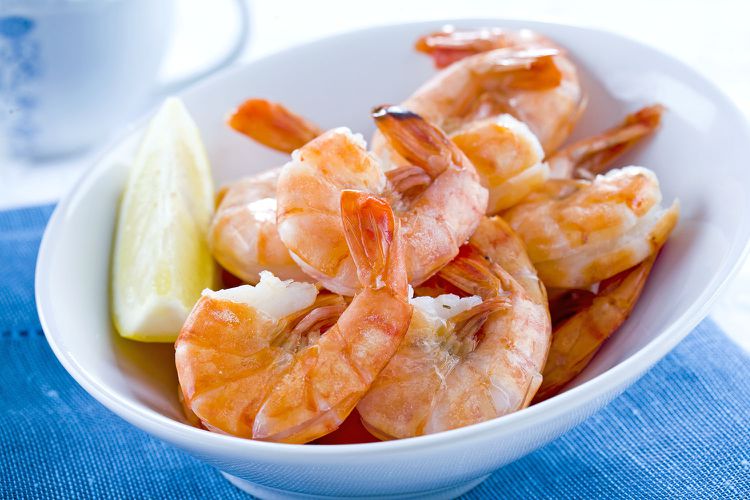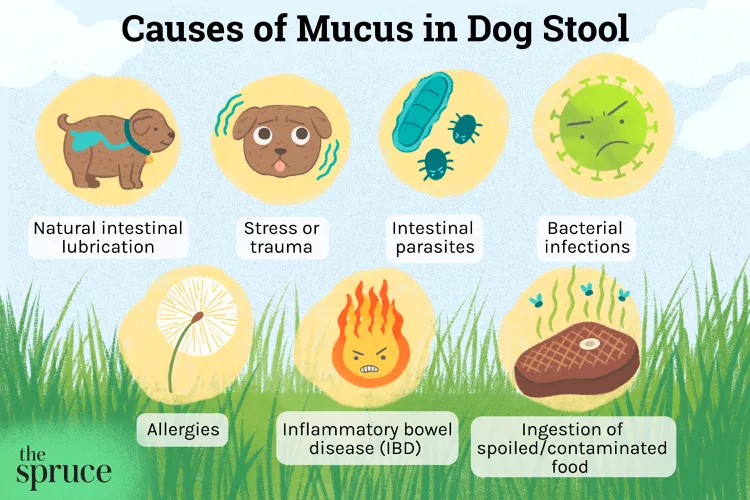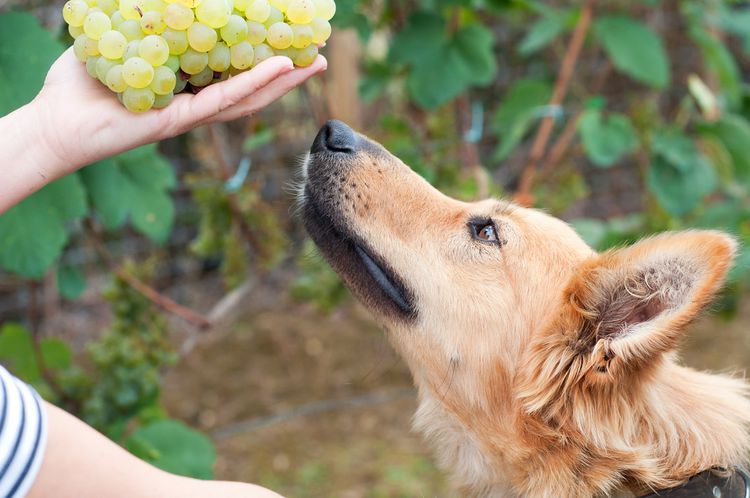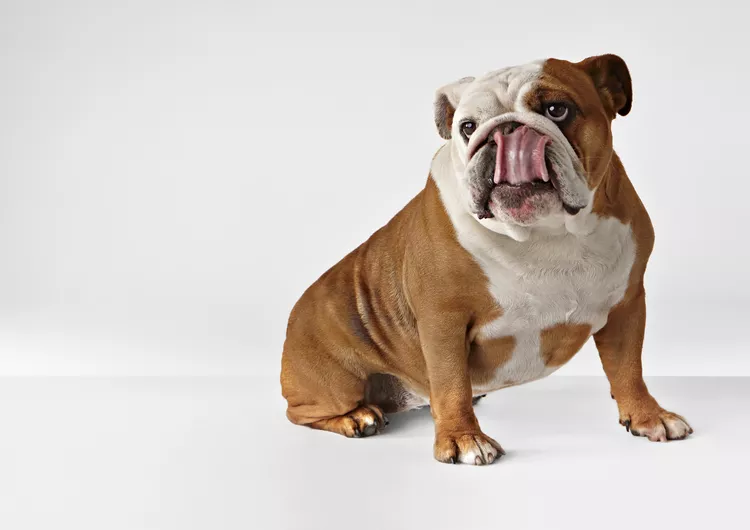
Shrimp is a popular seafood item. Whether it’s grilled, fried, or shrimp cocktail, the average American eats about 4 pounds of shrimp each year. It’s low in calories but high in omega 3 fatty acids as well as iodine and other vitamins and minerals. What if your pup sneaks a piece of shrimp during meal prep or dinner? Is shrimp bad for dogs?
The short answer here is maybe—in small amounts and depending on the dog. Shrimp can be packed with nutrients. In addition to omega 3 fatty acids and iodine, it can be a great source of selenium, Vitamin B12, choline, copper, and phosphorus.
Iodine is vital to help regulate thyroid function. Selenium is a powerful antioxidant. Vitamin B12 (sometimes called cobalamin) has beneficial effects for both the brain and nervous system as well as red blood cell formation. Choline helps with memory, mood, and muscle control. Copper aids in the absorption of iron. It also works with that iron to also aid in red blood cell formation. It can even aid in the prevention of heart disease and osteoporosis. Phosphorous is used in the formation of bones as well as teeth.
These health benefits in people mean that shrimp could be a nutritious snack in small, controlled amounts for many dogs, too. However, your dog is already receiving all of the nutrition, vitamins, and minerals they need through their commercial dog food. But any treat, including shrimp, should not make up more than ten percent of your dog's daily food intake. Giving more than this could lead to a nutritional imbalance or health condition.
While shrimp can be packed with vitamins and minerals, there are things to know before feeding them to your dog. In people, the rate of shellfish allergy ranges between 0.5-2.5 percent of the general population. While there isn’t any hard research on the actual numbers in dogs, it is believed that it is just as equally rare for dogs to have shellfish allergies. In fact, in one study, the most common food allergens were listed as being beef, dairy, chicken, wheat, and lamb, with beef being the most common of the five and lamb being the least.
That being said, it’s still possible for a dog to have a shellfish allergy. While most dogs exhibit food allergies as either gastrointestinal upset or skin/ear infections, an anaphylactic reaction is always possible. If you notice your dog having facial swelling, hives, or any difficulty breathing, seek veterinary care immediately.
Just because shrimp is full of nutrients doesn’t mean it’s healthy regardless of how it’s prepared. This goes for people as well as dogs. There’s a reason restaurants note the danger of eating raw or undercooked shrimp on their menus.
Consuming raw shrimp, whether in sushi, sashimi, or ceviche, can lead to something called vibriosis. This is an infection caused by a marine bacterium called Vibrio vulnificus. While most cases resolve, about 20 percent of cases in people leads to death. Another bacterial contaminant in raw shrimp can include another species of the Vibrio genera and that’s Vibrio cholerae. You may have already guessed, but this bacteria can actually cause cholera. While this may seem like an illness from hundreds of years ago, it’s still prevalent in many parts of the globe.
Raw shrimp doesn’t just carry a risk of bacterial infection, though. Shrimp can also be contaminated with parasites. If not prepared safely, there’s a real risk those parasites can be transferred to whoever eats it, whether that’s you or your dog.
Fried shrimp is also something to avoid. The extra grease and fat can lead to stomach upset such as vomiting, diarrhea, and even pancreatitis. It can also predispose your dog to weight gain.
The "peel and eat" style of shrimp would be suitable because they are precooked. Just know that you still have to peel them for your pup. The chitinous outer layer that is peeled off cannot be easily digested by dogs and, as such, may cause gastrointestinal upset. For this reason, you should never feed shrimp tails to your dog, either.
Small quantities of grilled shrimp can be safely fed to dogs as long as there are no added sauces or seasoning. Be sure to grill them to proper internal temperature so that they are safe for consumption. Boiling would be another way to prepare shrimp for your dog, if grilling is not an option. Again, just be sure they are cooked through.
If you are purchasing fresh or frozen shrimp to cook for your dog, you also need to remember to devein them. The tail vein, as it’s commonly called, runs along the back of the shrimp. The term "vein" is a bit of a misnomer, as its actually part of the shrimp’s GI tract. It is imperative to always devein shrimp before cooking, whether for you or your pooch.
So while shrimp may have some nutritional benefits for your dog, there are definitely things to know about before feeding them some. The most important takeaway is that moderation is key—an occasional bite of plain cooked shrimp should be safe for most dogs.

212 Hairless Cat Names For Your Beautifully Bald Feline
Discover the perfect name for your hairless cat with our list of over 200 creative and unique names. From quirky to classic, find a fitting choice for your beautifully bald feline companion.
8 Things Your Cat Loves
Just like humans, cats can have a long list of things they like. Find out what cats love so you can keep your cat happy and healthy.
How to Tell If a Kitten is a Boy or a Girl
If you're wondering whether your new kitten is a boy or a girl, here are three ways to help determine the sex of your cat.
8 Tips to Help Cats Enjoy Car Travel
Cats are creatures of habit, and they hate to travel. Learn tips to prepare them for travel in the car, whether going to the vet or on vacation.
Common Causes of Mucus in Dog Poop
Seeing mucus in your dog's poop can be concerning to a dog owner. Here are common causes and treatment of mucus in a dog's stool.
Is Shrimp Bad For Dogs?
Shrimp can be a healthy, nutritional food for people but can dogs eat them, too? What are the main concerns with feeding shrimp to your dog?
Can Dogs Eat Grapes?
Are grapes safe for dogs? Grapes and raisins can cause serious toxicity in dogs. Find out what to do if your dog eats grapes.
Maine Coon Cat: Breed Profile, Characteristics & Care
The Maine Coon cat is of the largest cat breeds in the world. These amiable, gentle cats make great companions. Learn about the Maine Coon cat breed's appearance, temperament, health, and care needs.
Selkirk Rex: Cat Breed Profile, Characteristics & Care
The Selkirk Rex is a charming cat with a tousled coat and a loving, laid-back personality. Learn about the Selkirk Rex breed.
How to Stop Your Cat From Chewing Electrical Cords
Cats are known to pounce and attack inanimate objects, like electrical cords. Learn how to prevent your cat from ambushing objects that may harm it.
What Do Cats Think About?
Have you ever wondered what cats think about? A number of studies have explored cat behavior and feline cognition, but there's still more to learn.
Training Your Kitten to Use the Litter Box
Bringing home a new kitten means they need to learn how to properly use a litter box. Discover how to successfully litter box train your kitten.
Why Do Cats Knead?
Kneading is a common behavior in cats of all ages. Learn why cats "make biscuits" and what it means for you, your cat, and all your blankets.
Dandie Dinmont Terrier: Dog Breed Characteristics & Care
Learn about the Dandie Dinmont Terrier, a silky dog breed with a signature puff of hair atop its head and a friendly, companionable personality.
Tibetan Mastiff: Dog Breed Characteristics & Care
Learn about the Tibetan mastiff, an ancient guardian dog breed. This breed is known for their massive stature, flowing mane, and protective personality.
4 Reasons Why Your Dog Licks Their Butt
Butt-licking in dogs can be a part of normal grooming, but excessive butt-licking is not normal. Read about the most common reasons for this behavior.
How to Teach Your Dog the "Leave It" Command
Training your dog the "leave it" command is a great way to instill self-control. Learn how to teach your dog to not pick things up from the ground.
How to Solve Your Dog's Fear of Car Rides
Is your dog scared of car rides? This fear of riding in cars is common. Learn why your dog is scared of car rides and how to help conquer this fear.
Can Dogs Get Depression? How to Help Your Sad Dog
Can dogs get depression? Learn about the signs of depression in dogs and find out how to help your sad dog.
How to Play Tug of War With Your Dog
Many dogs love to play tug of war, and it's a healthy game that provides great exercise. Learn the best way to safely play tug of war with your dog.